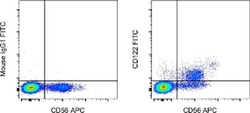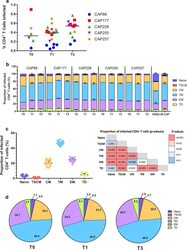Antibody data
- Antibody Data
- Antigen structure
- References [6]
- Comments [0]
- Validations
- Flow cytometry [1]
- Other assay [1]
Submit
Validation data
Reference
Comment
Report error
- Product number
- 11-1228-42 - Provider product page

- Provider
- Invitrogen Antibodies
- Product name
- CD122 Monoclonal Antibody (TU27), FITC, eBioscience™
- Antibody type
- Monoclonal
- Antigen
- Other
- Description
- Description: This TU27 monoclonal antibody reacts with human CD122, which is also known as interleukin-2 receptor beta (IL-2R beta). This receptor is expressed on NK cells, activated T cells, some B cells, monocytes, and T cell leukemias. CD122 can also be detected during early NK cell commitment. IL-2R beta associates with the IL-2R alpha (CD25) or IL-15R alpha and common gamma chain (CD132) to form the high affinity IL-2 and IL-15 receptors, respectively. By itself, this membrane receptor can bind IL-2, but with intermediate affinity. The binding of IL-2 results in internalization of the cytokine, tyrosine phosphorylation of IL-2Rbeta, and activation of signaling cascades such as the JAK/STAT pathway. Applications Reported: This TU27 antibody has been reported for use in flow cytometric analysis. Applications Tested: This TU27 antibody has been pre-titrated and tested by flow cytometric analyis of normal human peripheral blood cells. This can be used at 5 µL (0.5 µg) per test. A test is defined as the amount (µg) of antibody that will stain a cell sample in a final volume of 100 µL. Cell number should be determined empirically but can range from 10^5 to 10^8 cells/test. Excitation: 488 nm; Emission: 520 nm; Laser: Blue Laser. Filtration: 0.2 µm post-manufacturing filtered.
- Reactivity
- Human
- Host
- Mouse
- Conjugate
- Green dye
- Isotype
- IgG
- Antibody clone number
- TU27
- Vial size
- 100 Tests
- Concentration
- 5 μL/Test
- Storage
- 4°C, store in dark, DO NOT FREEZE!
Submitted references Longitudinal analysis of subtype C envelope tropism for memory CD4(+) T cell subsets over the first 3 years of untreated HIV-1 infection.
A novel human IL2RB mutation results in T and NK cell-driven immune dysregulation.
Differential expression of the interleukin 2 receptor beta (p75) chain on human peripheral blood natural killer subsets.
Interleukin 2-induced tyrosine phosphorylation. Interleukin 2 receptor beta is tyrosine phosphorylated.
Interleukin-2 receptor beta chain gene: generation of three receptor forms by cloned human alpha and beta chain cDNA's.
Novel interleukin-2 receptor subunit detected by cross-linking under high-affinity conditions.
Gartner MJ, Gorry PR, Tumpach C, Zhou J, Dantanarayana A, Chang JJ, Angelovich TA, Ellenberg P, Laumaea AE, Nonyane M, Moore PL, Lewin SR, Churchill MJ, Flynn JK, Roche M
Retrovirology 2020 Aug 6;17(1):24
Retrovirology 2020 Aug 6;17(1):24
A novel human IL2RB mutation results in T and NK cell-driven immune dysregulation.
Fernandez IZ, Baxter RM, Garcia-Perez JE, Vendrame E, Ranganath T, Kong DS, Lundquist K, Nguyen T, Ogolla S, Black J, Galambos C, Gumbart JC, Dawany N, Kelsen JR, de Zoeten EF, Quinones R, Eissa H, Verneris MR, Sullivan KE, Rochford R, Blish CA, Kedl RM, Dutmer CM, Hsieh EWY
The Journal of experimental medicine 2019 Jun 3;216(6):1255-1267
The Journal of experimental medicine 2019 Jun 3;216(6):1255-1267
Differential expression of the interleukin 2 receptor beta (p75) chain on human peripheral blood natural killer subsets.
Nishikawa K, Saito S, Morii T, Kato Y, Narita N, Ichijo M, Ohashi Y, Takeshita T, Sugamura K
International immunology 1990;2(6):481-6
International immunology 1990;2(6):481-6
Interleukin 2-induced tyrosine phosphorylation. Interleukin 2 receptor beta is tyrosine phosphorylated.
Mills GB, May C, McGill M, Fung M, Baker M, Sutherland R, Greene WC
The Journal of biological chemistry 1990 Feb 25;265(6):3561-7
The Journal of biological chemistry 1990 Feb 25;265(6):3561-7
Interleukin-2 receptor beta chain gene: generation of three receptor forms by cloned human alpha and beta chain cDNA's.
Hatakeyama M, Tsudo M, Minamoto S, Kono T, Doi T, Miyata T, Miyasaka M, Taniguchi T
Science (New York, N.Y.) 1989 May 5;244(4904):551-6
Science (New York, N.Y.) 1989 May 5;244(4904):551-6
Novel interleukin-2 receptor subunit detected by cross-linking under high-affinity conditions.
Sharon M, Klausner RD, Cullen BR, Chizzonite R, Leonard WJ
Science (New York, N.Y.) 1986 Nov 14;234(4778):859-63
Science (New York, N.Y.) 1986 Nov 14;234(4778):859-63
No comments: Submit comment
Supportive validation
- Submitted by
- Invitrogen Antibodies (provider)
- Main image

- Experimental details
- Staining of normal human peripheral blood cells with Anti-Human CD56 (NCAM) APC (Product # 17-0567-42) and Mouse IgG1 K Isotype Control FITC (Product # 11-4714-42) (left) or Anti-Human CD122 FITC (right). Cells in the lymphocyte gate were used for analysis.
Supportive validation
- Submitted by
- Invitrogen Antibodies (provider)
- Main image

- Experimental details
- Fig. 3 Transitional memory and effector memory cells were most frequently infected by C-HIV Envs. a Each data point represents the percentage of infected CD4 + T cells with one pseudovirus (averaged from four independent seronegative blood bank donors). The Env donor is indicated as follows; CAP88 (blue circles), CAP177 (red squares), CAP228 (green triangles), CAP255 (purple inverted triangles) and CAP257 (orange diamonds). Black lines represents the median of all pseudoviruses within each time point. Comparisons were made using a Kruskal-Wallis test with Dunn's post hoc test for multiple comparisons. b Stacked bar graphs represent the contribution of each T cell subset to the pool of infected CD4 + T cells. Values represent the median percentage of infected CD4 + T-cells (averaged across four HIV-seronegative PBMC donors) that belong to the indicated subset [naive; dark blue, T stem cell memory (TSCM); red, central memory (CM); yellow, transitional memory (TM); light blue, effector memory (EM); purple and terminally differentiated (TD); green], and are stratified by participant and time point. Error bars represent the interquartile range. c Dot plot representing the proportion of each T cell subset contributing to the total pool of infected cells for all Env-pseudoviruses. Each point represents a single virus averaged across four seronegative donors, lines represent median and error bars represent interquartile range. Comparisons were made using a Kruskal-Wallis test with Du
- Conjugate
- Green dye
 Explore
Explore Validate
Validate Learn
Learn Flow cytometry
Flow cytometry